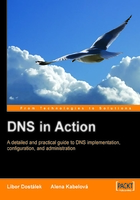
1.3 Reverse Domains
We have already said that communication between hosts is based on IP addresses, not domain names. On the other hand, some applications need to find a name for an IP address—in other words, find the reverse record. This process is the translation of an IP address into a domain name, which is often called reverse translation.
As with domains, IP addresses also create a tree structure (see Figure 1.2). Domains created by IP addresses are often called reverse domains. The pseudodomains inaddr-arpa for IPv4 and IP6.arpa for IPv6 were created for the purpose of reverse translation. This domain name has historical origins; it is an acronym for inverse addresses in the Arpanet.
Under the domain in-addr.arpa, there are domains with the same name as the first number from the network IP address. For example, the in-addr.arpa domain has subdomains 0 to 255. Each of these subdomains also contains lower subdomains 0 to 255. For example, network 195.47.37.0/24 belongs to subdomain 195.in-addr.arpa. This actual subdomain belongs to domain 47.195.in-addr.arpa, and so forth. Note that the domains here are created like network IP addresses written backwards.

Figure 1.2: Reverse domain to IP address 195.47.37.2
This whole mechanism works if the IP addresses of classes A, B, or C are affiliated. But what should you do if you only have a subnetwork of class C affiliated? Can you even run your own name server for reverse translation? The answer is yes. Even though the IP address only has four bytes and a classic reverse domain has a maximum of three numbers (the fourth numbers are already elements of the domain—IP addresses), the reverse domains for subnets of class C are created with four numbers. For example, for subnetwork 194.149.150.16/28 we will use domain 16.150.149.194.in-addr.arpa. It is as if the IP address suddenly has five bytes! This was originally a mistake in the implementation of DNS, but later this mistake proved to be very practical so it was standardized as an RFC. We will discuss this in more detail in Chapter 7. You will learn more about reverse domains for IPv6 in Section 3.5.3.